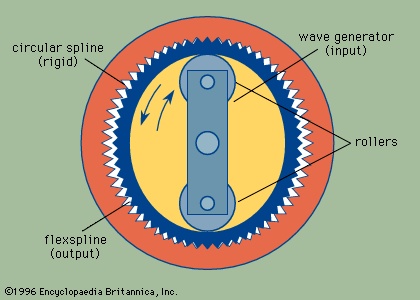Harmonic Drive
machine component
mechanical speed-changing device, invented in the 1950s, that operates on a different principle from, and has capabilities beyond the scope of, conventional speed changers. It consists of a thin ring that deflects elastically as it rolls on the inside of a slightly larger rigid circular ring.
 The three elements of the basic Harmonic Drive are shown in the Figure-->
The three elements of the basic Harmonic Drive are shown in the Figure--> . The circular spline has internal teeth that mesh with external teeth on the flexspline. The flexspline has fewer teeth and consequently a smaller effective diameter than the circular spline. The wave generator is a link with two rollers that rotates within the flexspline, causing it to mesh with the circular spline progressively at diametrically opposite points. If the wave generator (the input) rotates clockwise while the circular spline is fixed, the flexspline (the output) will rotate or roll around on the inside of the circular spline at a much slower rate in a counterclockwise direction.
. The circular spline has internal teeth that mesh with external teeth on the flexspline. The flexspline has fewer teeth and consequently a smaller effective diameter than the circular spline. The wave generator is a link with two rollers that rotates within the flexspline, causing it to mesh with the circular spline progressively at diametrically opposite points. If the wave generator (the input) rotates clockwise while the circular spline is fixed, the flexspline (the output) will rotate or roll around on the inside of the circular spline at a much slower rate in a counterclockwise direction.The ratio of the input speed to the output speed depends on the difference in the number of teeth in the circular spline and in the flexspline. Speed ratios as high as 320 to 1 can be produced in single-reduction Harmonic Drives that are lighter, smaller, and more efficient than conventional high-ratio drives. Compound drives can produce ratios as high as 1,000,000 to 1. Either the circular spline, the flexspline, or the wave generator may be fixed while the other two elements serve as input and output.
A unique and useful characteristic of the Harmonic Drive is its ability to transmit motion through sealed walls. The flexspline teeth can be placed near the centre of a long, hermetically sealed, flexible, cylindrical tube. The wave generator can be inside the tube and by its rotation deflect the flexspline and produce a slow rotation of the encircling circular spline. A rotary-to-linear version of the Harmonic Drive uses a screw and moves the control rod in a nuclear reactor head without mechanical contact through a sealed tube. Harmonic Drives have been employed in a variety of applications that range from such low-cost consumer applications as vending machines and rotating home-television antennas to sophisticated systems for military and aerospace use.
- Courier-Journal, The
- Courier, Paul-Louis
- Courland
- Cournand, André F.
- Cournot, Antoine-Augustin
- Courrières mining disaster
- Courrèges, André
- courser
- coursing
- court
- Court, Antoine
- Courtauld Institute Galleries
- court baron
- court cupboard
- Court de Gébelin, Antoine
- Courteen, Sir William
- Courteline, Georges
- Courtenay
- Courtenay, William
- courtesy literature
- Courthope, William John
- court leet
- courtly love
- Court, Margaret
- Stecknitz Canal